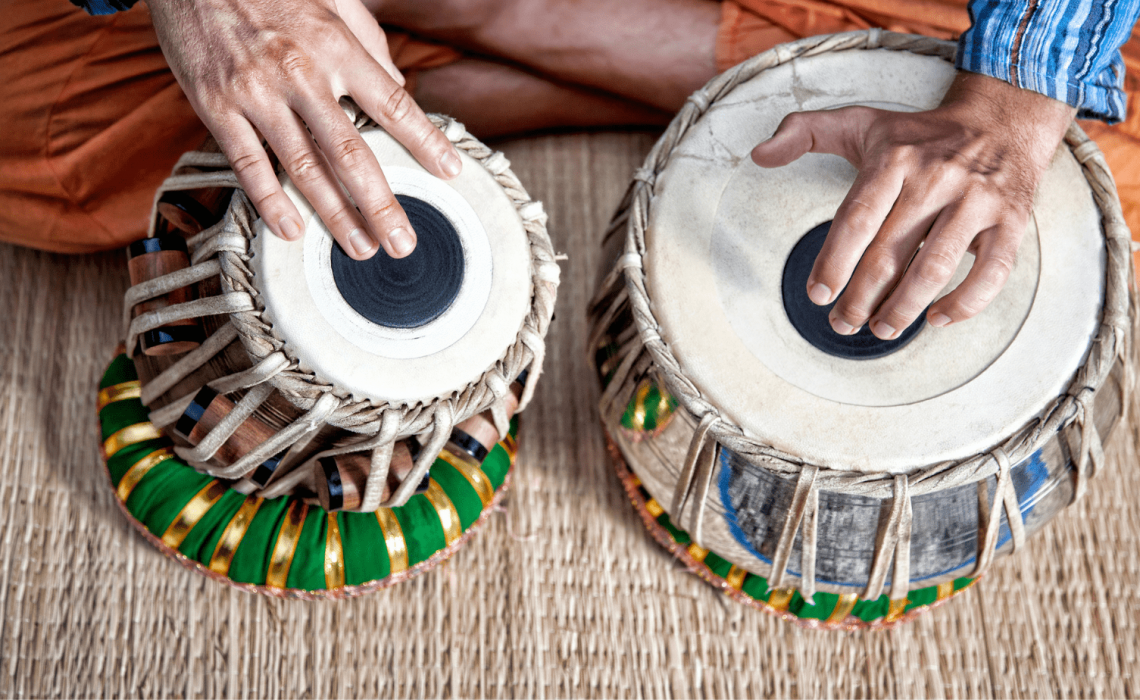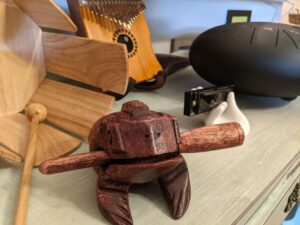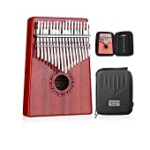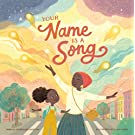First, we’ll dive into what is music and what is its purpose. Then we’ll learn how it’s been used since the dawn of humanity. Plus, we’ll unpack how music is so much more than “just” entertainment. And lastly, we’ll cover the 8 core elements of music, divided into 4 cornerstones (tempo, dynamics, rhythm, form) and 4 expressive qualities (melody, harmony, timbre, meter).
What is music?
According to the Merriam-Webster dictionary, music is
"the science or art of ordering tones or sounds in succession, in combination, and in temporal relationships to produce a composition having unity and continuity."
In other words, music is the art of producing pleasing, expressive combinations of tones, usually to evoke an emotional response. Additionally, the ability to enjoy music is a uniquely human experience. Unlike other species, listening to music can flood the human brain with dopamine, a chemical associated with pleasure, motivation and reward.
But, that’s not all.
Music is also an essential human survival need. (This is where the misunderstandings start to appear.) First, it allows us to express feelings when we don’t have the words. Second, it helps us make sense of life. Third, we’re able to understand and connect with others, learn a common language and belong to a tribe/culture through musical experiences. There is no other art form that encompasses all of these things. Therefore, music is not solely for entertainment. In short, music is about survival of our species.

What is the purpose of music?
Music dates back to the start of humanity and has been used for three main reasons throughout history:
- Celebrating cultural traditions
- Recreational purposes
- Artistic expression
Archaeologists have also found primitive flutes made of bone and ivory dating back as far as 43,000 years. It’s likely that many ancient musical styles have been preserved through oral traditions, as well.
Furthermore, music acts as a unifying bridge within a group of people. It connects you with others, helps you find your own identity within the culture, as well as provides deeper meaning to life’s transitions.
In fact, music is so crucial to humanity that your musical journey starts even before you’re born! We are lulled and comforted by the rhythmic heartbeat sounds in the womb, for nine straight months. After which, we land earth-side and continue to process the overall flow of our native tongue, the melody of the language if you will, long before comprehension and speaking come along.
Universal Elements of music
All music is composed of the same basic building blocks, just organized in different ways. Additionally, each culture from around the world has a preference for certain elements (rhythmic structures, form, melodic phrasing, etc). As a result, each culture places a stronger emphasis (and importance) on those different aspects in their music. This is how we’re able to identify certain music as belonging to certain parts of the world, even if we’ve never heard that exact piece before.

4 cornerstones of music
I refer to these first four elements as the “cornerstones” because they provide a solid, musical base. It’s on this base that the musicians then add nuance and musicality, within their tone color, melodic phrasing, emphasis of meter, etc. Of course, there can be nuance to the cornerstones as well, but typically they’re pretty stable. Once they’re set, they’re set.
Tempo
Tempo refers to the speed of the music. There are 3 ways to communicate the tempo of the music: BPM (beats per minute), Italian terminology, and modern language.
“Beats per Minute” is the most precise measurement, giving you an exact number of beats that will occur… wait for it… each minute. For example, 60bpm means one beat per second. Look at the second hand on a clock to see a visual representation of this tempo in action. Meanwhile, 120bpm would be twice as fast, 2 beats per second.
Italian terms convey a more descriptive explanation of the tempo, such as,
- Largo – broadly, slowly
- Andante – at a walking pace
- Allegro – quick, bright, joyful
- Presto – very, very fast
And lastly, you can describe tempo in modern terms such as “fast”, “slow”, etc.
Take a listen to some examples of different tempo below.
Dynamics
Dynamics show the volume of the music. These terms are also written in Italian. Here are some examples,
- Piano – quiet, soft
- Forte (FOR-tay) – loud, strong
You may also see the word mezzo (MET-so) which can be placed in front of the dynamic to modify it. For example,
- mezzo piano – moderately soft, medium soft
Or, if you want to get really fancy, add “-issimo” to the end of the dynamic for extra oomph,
- Pianissimo – very soft
- Fortissimo – very loud
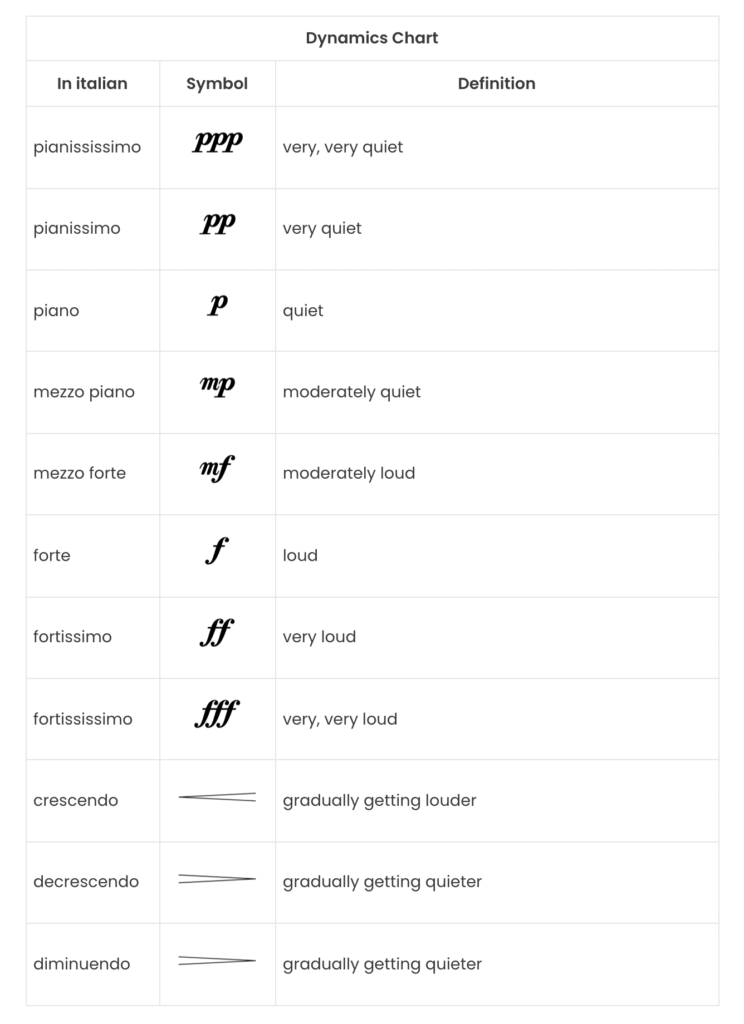
Subsequently, there are even more terms to convey “gradually getting louder” or “gradually getting softer”. See the chart above for a complete list of dynamics, symbols and meanings.
Here’s a short clip below that highlights several dynamics. Listen for the diminuendo at the end!
Rhythm
Rhythm refers to the placement and pattern of sounds and silences over time. It can be notated as seen in the chart on the right, where each type of rhythmic note has a specific duration. As you can see, the whole note has the longest duration and sixteenth notes have the shortest.
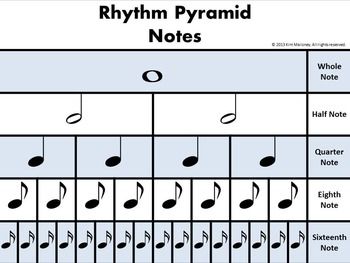
It’s the combination of these strong and weak beats (plus rests) that give specific styles their signature feel. For example, jazz often involves syncopation, or uneven rhythmic accents, while classical music is usually very defined and regular. Indian music rhythms are often in complex cycles of five, seven, nine or ten beats while Japanese music has many blank spaces (rests) between the sounds.
Listen to some Japanese Taiko drumming below to hear rhythm in action.
Form
Musical form describes the structure of the music, or how the sections are organized. Does the main theme repeat throughout the piece, intermixed with contrasting parts? Are there only two distinct sections? Is it rhythm and blues? Here are some common forms of music,
- AB (Verse and chorus)
- ABC (Verse, chorus, bridge)
- Rondo (ABACADA), Theme and variations
- Song cycle (set of related songs)
- Suite (set of similar dances)
- 12-bar blues
- Movements (as part of a symphony, opera, ballet)

4 Expressive Qualities of music
The next four musical aspects are where the real juicy magic happens, in my personal opinion. This is where musicians can play, stretch, evoke, harness and sweep us along on their emotional, musical journey. They do this by highlighting key notes in the melody, playing with the phrasing, stylistic accents and adding emotions.
Melody
The main tune of the music is called the melody. This is usually the easiest part to hear and it’s the part you can sing along with. The melody also sets the:
- Key signature (a select group of notes that belong to a specific scale)
- Mode (the way the notes are organized and emphasized)
- Major or minor intervals (the distance between two pitches)
In the most basic sense, major can be described as “happy, cheerful” and minor as “dark, somber, reflective”.
In the following example, the singer sings the melody, while a strong, steady drumbeat plays in the background.
Harmony
Harmony involves the combination of simultaneous notes to produce chords and chord progressions. Beethoven is famous for his powerful, electrifying harmonies, especially in his symphonies, as you’ll hear below.
My personal favorite Beethoven symphony is Symphony No. 5. Once a horn player, always a horn player, what can I say. Check it out below and you’ll hear what I’m talking about.
Timbre
Timbre, pronounced TAM-ber, is a way to describe the texture and tone color of the music. This is usually as a result of the chosen instrumentation. Is it a full orchestra? Guitar and vocals? Brass band? Each one of these groups will sound completely different, even if they all play the same piece of music. That’s timbre.
Listen to the various soloists in this next clip and compare the timbres.
Meter
Lastly, that brings us to meter, also known as time signature. This shows how the beat is grouped together. The two most common meters in Western music are 2 meter (duple) and 3 meter (triple).
I like to refer to 2 meter as the marching meter, 1-2, 1-2, left-right, left-right. The 3 meter, however, matches a waltz dance, 1-2-3, 1-2-3, 1-2-3. With each type of meter there will also be an accent, or slight stress, to a particular beat number. For example, 2 meter stresses the “1”, as in, ONE-two, ONE-two, ONE-two. The 3 meter follows the same, as in, ONE-two-three, ONE-two-three, ONE-two-three. A 5 meter on the other hand might be stressed as, ONE-two-THREE-four-five, ONE-two-THREE-four-five or even, ONE-two-three-FOUR-five, ONE-two-three-FOUR-five.
Listen to an example of some common meters below.
2 Main Styles of Music
Since music is an artistic form it’s very subjective and difficult to classify into definite styles or genres. If we zoom way out, however, we can break it down into two main groups: “religious” vs “secular”, or even, “popular” vs “art” music. Within those two main parent groups are endless genres and sub-genres and combinations of genres. Not to mention, new styles are being formed every day.

And that's a wrap!
Now to review, we began this article by answering the timeless question: What is music? We also expanded on the traditional dictionary definition and shared how music is actually much more than “just” entertainment. It’s a way to belong, connect, communicate and express ourselves, as unique human beings living intentional, imperfect lives.
Lastly, we discussed the 8 essential elements of music, starting with the 4 cornerstones (tempo, dynamics, rhythm, form) and ending with the 4 expressive qualities (timbre, melody, harmony, timbre). We learned how different cultures around the world (as well as throughout history), emphasize different musical aspects to create their signature music style. This is how we’re able to identify where different music comes from, without ever hearing it before.
As you can see, it truly takes a masterful, creative, genius composer to weave all the various elements of music together in order to envelop the listener in a powerful, transformative, musical story. It takes an equally expressive musician to communicate that journey to the audience. All the while putting a little bit of themself into the mix, too. It’s for that reason that no two musical performances are ever, ever the same.
I’d hate to live in a world without music, wouldn’t you?
Over to you
>> Tell us in the comments, what do you love about music?
>> If you’re looking for ways to incorporate more music into your daily family life, make sure you grab your FREE Top 10 Musical Tips Guide right here.

